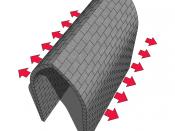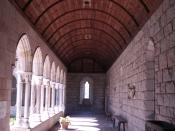The style of architecture immediately preceding Gothic within Europe is known as Romanesque. The term Romanesque, like many other stylistic designations, was not a term contemporary within the art it describes but an invention of modern scholarship to categorize a period. The term Romanesque attempts to link the architecture, especially, of the 11th and 12th centuries in medieval Europe to roman architecture based on similarities of form and material. The Romanesque period, from roughly 1000 to 1100 A.D has been dubbed the "Period of the Church Triumphant". It was during these years that the Catholic Church was able to unify Western Europe in a manner unparalleled since roman times. The era in which the Romanesque structures arose was a time of great significance for European culture. Hundreds of years of chaos were passing as new orders began to take shape across the continent. As the first millennium drew to a close, the church had become the dominant influence and promoter of art and culture.
The year 1,000 was an important milestone in this period as it was prophesied that the end of the world would occur on this date. When it passed without disaster a strong impetus for renewal emerged throughout Western Europe. Considerable social change began to take place. Crusades to Spain and the holy land brought back learning and technology from the Islamic and Byzantine cultures. Newly established monastic orders created centers of learning and culture, and became important patrons of the arts and architecture.
The architects of this era emulated ancient roman devices. It also takes inspiration from the German, Ottoman and Byzantine styles. There are many regional styles and local variations in Romanesque buildings but they all have common roots in the roman basilica. Used in towns and cities as a market and meeting hall,


